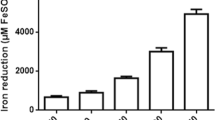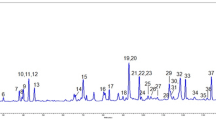Abstract
Molecules exhibiting antioxidant, neuroprotective, and regulatory properties inherent to natural products consumed by humans are gaining attention in biomedical research. Ferulic acid (FA) is a phenolic compound possessing antioxidant and cytoprotective properties. It is found in several vegetables, including sugarcane, where it serves as the main antioxidant component. Here, we compared the antioxidant and cytoprotective effects of FA with those of the total sugarcane aqueous extract (SCAE). Specifically, we assessed biochemical markers of cell dysfunction in rat cortical brain slices and markers of physiological stress in Caenorhabditis elegans upon exposure to toxins evoking different mechanisms of neurotoxicity, including direct oxidative stress and/or excitotoxicity. In rat cortical slices, FA (250 and 500 μM), but not SCAE (~ 270 μM of total polyphenols), prevented the loss of reductive capacity induced by the excitotoxin quinolinic acid (QUIN, 100 μM), the pro-oxidant agent ferrous sulfate (FeSO4, 25 μM), and the dopaminergic pro-oxidant 6-hydroxydopamine (6-OHDA, 100 μM). In wild-type (N2) C. elegans, FA (38 mM) exerted protective effects on decreased survival induced by FeSO4 (15 mM) and 6-OHDA (25 mM), and the motor alterations induced by QUIN (100 mM), FeSO4, and 6-OHDA. In contrast, SCAE (~ 13.5 mM of total polyphenols) evoked protective effects on the decreased survival induced by the three toxic agents, the motor alterations induced by FeSO4, and the reproductive deficit induced by FeSO4. In addition, FA was unable to reverse the decreased survival induced by all these toxins in the skn-1−/− strain (VC1772), which lacks the homolog of mammalian Nrf2, a master antioxidant gene. Altogether, our results suggest that (1) both FA and SCAE afford protection against toxic conditions, (2) not all the effects inherent to SCAE are due to FA, and (3) FA requires the skn-1 pathway to exert its protective effects in C. elegans.





Similar content being viewed by others
References
Abbas SR, Sabir SM, Ahmad SD, Boligon AA, Athayde ML (2014) Phenolic profile, antioxidant potential and DNA damage protecting activity of sugarcane (Saccharum officinarum). Food Chem 147:10–16
Bhattacharya S, Christensen KB, Olsen LC, Christensen LP, Grevsen K, Færgeman NJ, Kristiansen K, Young JF, Oksbjerg N (2013) Bioactive components from flowers of Sambucus nigra L. increase glucose uptake in primary porcine myotube cultures and reduce fat accumulation in Caenorhabditis elegans. J Agric Food Chem 61:11033–11040
Blackwell TK, Steinbaugh MJ, Hourihan JM, Ewald CY, Isik M (2015) SKN-1/Nrf, stress responses, and aging in Caenorhabditis elegans. Free Radic Biol Med 88:290–301
Blandini F, Armentero MT (2012) Animal models of Parkinson’s disease. FEBS J 279:1156–1166
Colín-González AL, Luna-López A, Königsberg M, Ali SF, Pedraza-Chaverrí J, Santamaría A (2014) Early modulation of the transcription factor Nrf2 in rodent striatal slices by quinolinic acid, a toxic metabolite of the kynurenine pathway. Neuroscience 260:130–139
Di Paola Naranjo RD, Otaiza S, Saragusti AC, Baroni V, Carranza Adel V, Peralta IE, Valle EM, Carrari F, Asis R (2016) Hydrophilic antioxidants from Andean tomato landraces assessed by their bioactivities in vitro and in vivo. Food Chem 206:146–155
Gamberini MT, Gamberini MC, Nasello AG (2015) Involvement of dopaminergic and cholinergic pathways in the induction of yawning and genital grooming by the aqueous extract of Saccharum officinarum L. (sugarcane) in rats. Neurosci Lett 584:270–275
Ghosh S, Basak P, Dutta S, Chowdhury S, Sil PC (2017) New insights into the emerging ameliorative effects of ferulic acid in pathophysiological conditions. Food Chem Toxicol 103:41–55
Guillemin GJ (2012) Quinolinic acid, the inescapable neurotoxin. FEBS J 279:1356–1365
Jagota S, Rajadas J (2012) Effect of phenolic compounds against Aβ aggregation and Aβ-induced toxicity in transgenic C. elegans. Neurochem Res 37:40–48
Kanski J, Aksenova M, Stoyanova A, Butterfield DA (2002) Ferulic acid antioxidant protection against hydroxyl and peroxyl radical oxidation in synaptosomal and neuronal cell culture systems in vitro: structure-activity studies. J Nutr Biochem 13:273–281
Kotlar I, Colonnello A, Aguilera-González MF, Avila DS, de Lima ME, García-Contreras R, Ortíz-Plata A, Soares FAA, Aschner M, Santamaría A (2018) Comparison of the toxic effects of quinolinic acid and 3-nitropropionic acid in C. elegans: involvement of the SKN-1 pathway. Neurotox Res 2018 33: 259–267
Kumar N, Pruthi V (2014) Potential applications of ferulic acid from natural sources. Biosci. Rep. 4:86–93
Lai W, Wei Q, Zhuang J, Lu M, Tang D (2016) Fenton reaction-based colorimetric immunoassay for sensitive detection of brevetoxin B. Biosens Bioelectron 80:249–256
Ma ZC, Hong Q, Wang YG, Liang QD, Tan HL, Xiao CR, Tang XL, Shao S, Zhou SS, Gao Y (2011) Ferulic acid induces heme oxygenase-1 via activation of ERK and Nrf2. Drug Discov Ther 5:299–305
Mancuso C, Santangelo R (2014) Ferulic acid: pharmacological and toxicological aspects. Food Chem Toxicol 65:185–195
Pérez-De La Cruz V, Carrillo-Mora P, Santamaría A (2012) Quinolinic acid, an endogenous molecule combining excitotoxicity, oxidative stress and other toxic mechanisms. Int J Tryptohan Res 5:1–8
Pinho AI, Oliveira CS, Lovato FL, Waczuk EP, Piccoli BC, Boligon AA, Leite NF, Coutinho HDM, T1 P, Da Rocha JBT, Franco JL (2017) Antioxidant and mercury chelating activity of Psidium guajava var. pomifera L. leaves hydroalcoholic extract. J Toxicol Environ Health A 80:1301–1313
Powolny AA, Singh SV, Melov S, Hubbard A, Fisher AL (2011) The garlic constituent diallyl trisulfide increases the lifespan of C. elegans via skn-1 activation. Exp Gerontol 46:441–452
Salam S, Ansari A, Amon S, Rezai P, Selvaganapathy PR, Mishra RK, Gupta BP (2013) A microfluidic phenotype analysis system reveals function of sensory and dopaminergic neuron signaling in C. elegans electrotactic swimming behavior. Worm 2:e24558
Serratos IN, Castellanos P, Pastor N, Millán-Pacheco C, Rembao D, Pérez-Montfort R, Cabrera N, Reyes-Espinosa F, Díaz-Garrido P, López-Macay A, Martínez-Flores K, López-Reyes A, Sánchez-García A, Cuevas E, Santamaria A (2015) Modeling the interaction between quinolinate and the receptor for advanced glycation end products (RAGE): relevance for early neuropathological processes. PLoS One 10:e0120221
Serratos IN, Castellanos P, Pastor N, Millán-Pacheco C, Colín-González AL, Rembao D, Pérez-Montfort R, Cabrera C, Sánchez-García A, Gómez I, Rangel-López E, Santamaría A (2016) Early expression of the receptor for advanced glycation end products in a toxic model produced by 6-hydroxydopamine in the rat striatum. Chem Biol Interact 249:10–18
Shashikumar S, Pradeepa H, Chinnu S, Rajini PS, Rajanikant GK (2015) Alpha-linolenic acid suppresses dopaminergic neurodegeneration induced by 6-OHDA in C. elegans. Physiol Behav 151:563–569
Staab TA, Griffen TC, Corcoran C, Evgrafov O, Knowles JA, Sieburth D (2013) The conserved SKN-1/Nrf2 stress response pathway regulates synaptic function in Caenorhabditis elegans. PLoS Genet 9:e1003354
Sultana R (2012) Ferulic acid ethyl ester as a potential therapy in neurodegenerative disorders. Biochim Biophys Acta 1822:748–752
Ting KK, Brew BJ, Guillemin GJ (2009) Effect of quinolinic acid on human astrocytes morphology and functions: implications in Alzheimer’s disease. J Neuroinflammation 6:36
Zariwala MG, Elsaid N, Jackson JL, Corral-López F, Farnaud S, Somavarapu S, Renshaw D (2013) A novel approach to oral iron delivery using ferrous sulphate loaded solid lipid nanoparticles. Int J Pharm 456:400–407
Zeni AL, Zomkowski AD, Maraschin M, Rodrigues AL, Tasca CI (2012) Involvement of PKA, CaMKII, PKC, MAPK/ERK, and PI3K in the acute antidepressant-like effect of ferulic acid in the tail suspension test. Pharmacol Biochem Behav 103:181–186
Acknowledgments
The authors wish to express gratitude to Dr. Pan Chen for his excellent technical contribution.
Funding
MA has been supported in part by the National Institutes of Health grant numbers NIEHS R01ES07331, NIEHS R01ES10563, and NIEHS R01ES020852.
Author information
Authors and Affiliations
Corresponding author
Ethics declarations
Conflict of Interest
The authors declare that the research was conducted in the absence of any commercial or financial relationships that could be construed as a potential conflict of interest.
Rights and permissions
About this article
Cite this article
Colonnello, A., Kotlar, I., de Lima, M.E. et al. Comparing the Effects of Ferulic Acid and Sugarcane Aqueous Extract in In Vitro and In Vivo Neurotoxic Models. Neurotox Res 34, 640–648 (2018). https://doi.org/10.1007/s12640-018-9926-y
Received:
Revised:
Accepted:
Published:
Issue Date:
DOI: https://doi.org/10.1007/s12640-018-9926-y




